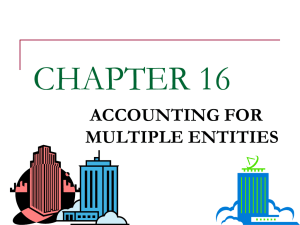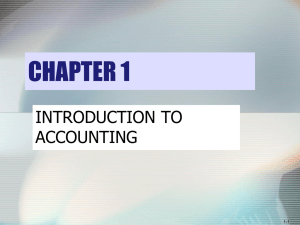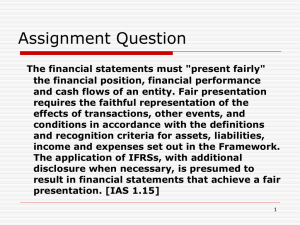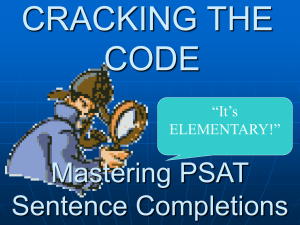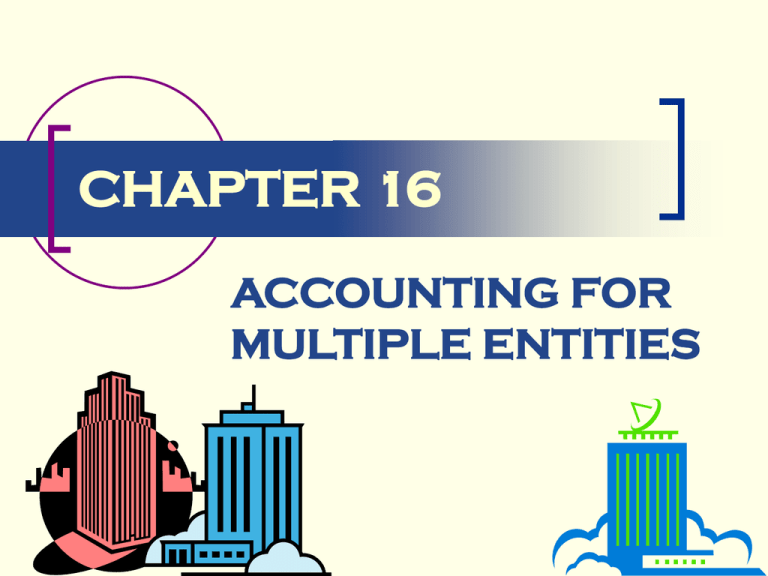
CHAPTER 16
ACCOUNTING FOR
MULTIPLE ENTITIES
Introduction
Businesses find it useful to
combine operations for
efficiencies of scale
Accounting issues for
multiple entities:
Business combinations
Consolidations and segment reporting
Foreign currency translation
Business Combinations
Wyatt’s classifications
1. Classical era
2. Second wave
3. Third era
Why do businesses
combine?
1. Tax consequences
2. Growth and diversification
3. Financial considerations
4. Competitive pressure
5. Profit and retirement
Business Combinations
Two methods of acquisition
1. cash
2. exchange of stock
Accounting Method
Accounting Treatment
Purchase
Fair Market Value
& Goodwill
Pooling of Interests
Book Value
Criticisms of the Pooling of
Interests Method
Accounting is distorted
Investment is not disclosed
Assets undervalued
Income overstated in
subsequent years
FASB decision
Economic consequences
arguments
The Fresh Start Method
Some combinations are a merger of
equals in which none of the
combined companies survive
Revalue all assets as if it were a
newly formed entity
The Purchase Method
Must be used
when one company acquires the net assets of
a business
and also obtains control over that business
SFAS No. 141 applies to both
incorporated and
unincorporated businesses
The Purchase Method
When a business combination is created by
an exchange of stock, SFAS No. 141 requires
that the following “pertinent facts and
circumstances” be taken into consideration:
a.
b.
c.
d.
e.
The relative voting rights
The existence of a large minority voting interest
The composition of the governing body
The composition of senior management
The terms of exchange of equity securities.
Subsequently allocate cost to all
identifiable assets with remainder to
goodwill
Consolidation
When one business organization has
control over another they should report as a
unified whole
Now required by SFAS No. 94
ARB No. 51 criteria
Parent-subsidiary relationship
Control
Maintenance of control
Operate as integrated unit
Approximate fiscal years
Principles
Cannot own or owe itself
Cannot make a profit by selling to itself
The Concept of Control
The power of one entity to direct or cause the
direction of the management and operating and
financing policies of another entity
Should control be presumed in
cases of less than 50% ownership?
Control is presumed when the parent
Owns the majority of the subsidiary’s outstanding
common stock
Has the ability to dominate the subsidiary’s board of
directors
Has the ability to dissolve the entity
The Modified Approach
to Control
FASB Exposure Draft
Asks the question:
Is consolidation required?
1.
Is the entity a special purpose entity and is it a
transferor or its affiliate?
2.
Are the permitted activities and powers of the entity
significantly linked?
3.
If not the presumption of control exists
Are powers limited? Can the party change the entity’s purpose?
4.
(Use SFAS No 140 criteria)
If so consolidate
Also consolidate if no new cash outlay or benefits exceed new cash
outlay
If step 3 does not require consolidation, assess whether
variable interests are significant
Theories of Consolidation
Entity theory
Emphasis is on control of
a group of legal entities
operating as a single unit
Parent company
theory
Purpose of consolidated
statements is to provide
information for parent
company stockholders
Minority Interest
Definition
Placement
Liability
Separately presented
Stockholder equity
Minority interest and theories of
consolidation
Doesn’t meet SFAC definition of liability
FASB ED suggests “non-controlling interest in
subsidiaries”
Additional Issues
Proportionate consolidation
ignore minority interest
Goodwill
Should it be attributed to
minority interest?
Drawbacks to consolidation
loss of information
Special Purpose Entities
Partnership, corporation, trust, or joint
venture
created for a limited purpose
limited life and limited activities
designed to benefit a single company
Primary motive for most SPEs
off-balance sheet financing
often to avoid reporting capital leases under SFAS No. 13.
Companies are able to avoid consolidation of SPEs in
which they do not have a majority voting interest
SPE is created by an asset transfer
The assets are sold to the SPE
To achieve off-balance sheet treatment
minimum (previously 3%, now 10%) investment from an
independent third party investor is required
Special Purpose Entities
SFAS No. 140, “Accounting for Transfers and Servicing of Financial
Assets and Extinguishments of Liabilities”
Outlines requirements to qualify an SPE for non-consolidation
Transferor company, has surrendered control over the transferred
assets (and thus has a sale) when all of the following conditions are
met:
a. The transferred assets have been put beyond the reach of the transferor
and its creditors
b. Each transferee (SPE) has the right to pledge or exchange the assets and
no conditions constrain the transferee from taking advantage of its right
to pledge or exchange
c. The transferor does not maintain effective control over
the transferred assets through either
1. an agreement that entitles and obligates the transferor to
repurchase or redeem the transferred assets before
maturity or
2. the ability to unilaterally cause the holder to return
specific assets, other than through a cleanup call
New FASB exposure draft
Segmental Reporting
How it became a factor
SEC line-of-business reporting
NYSE recommendations
Why important?
Various operations may have differing prospects for
growth rate of profitability and degrees of risk
Assessment of decentralized management
What to disclose
Operations in different industries
Foreign operations
Major customers
SFAS No 14 Criteria
Definition
Identity segment
Reportable segment
Revenue
Operating profit or loss
Identifiable assets
Reporting guidelines
Reportable segments
Information to be disclosed
Where to disclose
SFAS No. 131
Operating segment
Report balance sheet
and income statement
information about each operating segment
Include other specified information
if it is included in the measurement of segment
profit
Include other geographic information
Include reliance on major customers
Foreign Currency Translation
Foreign currency translation issues
Increase of foreign operations
Allowing dollar to float on world market
Necessary to state financial statements in a common
measuring unit
Problems:
When do you measure difference?
How do you translate specific assets and liabilities
Methods of translation
Current – Noncurrent
Monetary – Nonmonetary
Current
Temporal
The FASB and Foreign
Currency Translation
SFAS No. 8
Closely follows the temporal method
Measure in conformity with US GAAP
Record transactions at initial exchange rate
Use balance sheet date or measurement date as
basis for translation of balance sheet items
Use transaction date for revenues and expenses
Exchange gains and losses in income
Gains and losses from foreign exchange
contracts in income
The FASB and Foreign
Currency Translation
SFAS No. 52
SFAS No. 8 produced distortions
SFAS No. 52 adopted functional currency
approach
Record transactions in functional currency
Adjust, if necessary to comply with GAAP
Translate into currency of reporting company
Transaction gains and losses reported in OCI
If local currency is not functional currency gains and losses in income
The FASB and Foreign
Currency Translation
SFAS No. 52
Foreign exchange contract
One transaction
Two transactions
How viewed
International
Accounting Standards
The IASC has issued standards dealing with the
following issues:
IAS No. 27: Consolidated Financial
Statements and Accounting for
Investments in Subsidiaries
Revised statement does not change the
fundamental approach to accounting for
business combinations
Parent companies should present
consolidated financial statements
when it has the ability to control its subsidiaries which is similar to
U. S. GAAP.
Concept of control is defined somewhat differently.
IAS No. 27 defines control as the power to govern a subsidiary
U. S. GAAP focuses on ownership of a majority voting interest
Major Revisions to IAS No. 27
1. IAS No. 27 permits
wholly owned (and
virtually whollyowned) subsidiaries to
be excluded from
consolidation
2. If the exemption is
applied, an entity
should disclose:
a. the reason for not
publishing consolidated
financial statements
b. the name of the parent
that publishes
consolidated financial
statements that comply
with IFRS.
3. Minority interests
should be presented
in equity, separately
from parent
shareholders' equity.
4. The exemptions from
consolidation are
tightened
IAS No. 14: Reporting Financial
Information by Segment
Revised IAS No. 14 issued 7/97
Requires companies to report information
along product and service lines
and along geographical lines.
The two bases of segmentation termed
primary
secondary
Segments defined:
organizational units
for which information is reported
to the board of directors
IAS No. 14: Reporting Financial
Information by Segment
Contains 10% materiality
thresholds similar to U. S.
GAAP
Standard requires reported
segments to equal at lease
75% of consolidated revenue
FASB Review of IAS No. 14
Noted three significant differences
from SFAS No. 131:
1 The process for
identifying reportable
segments
2 The treatment for
vertically integrated
segments
3 The basis of accounting
IAS No 21: The Effects of Changes
in Foreign Exchange Rates
Initially record transactions at historical cost
Use monetary - nonmonetary method for subsequent
transactions
Translate monetary items at current rate
Translate nonmonetary items at either historical or current rate
depending upon when they were measured
Exchange gains and losses reported as a component of
stockholders’ equity
IAS No 21: The Effects of Changes
in Foreign Exchange Rates
Major revisions
FASB staff review
noted requirements similar
to U. S. GAAP except for
treatments of hedge
accounting and goodwill
expressed concern that
these differences might
impair interfirm
comparability
IFRS No 3:
Business Combinations
Requires all business combinations to be
accounted for using the purchase method
The pooling of interests method is prohibited
Acquirer must be
identified for all
business
combinations
IFRS No 3:
Business Combinations
The acquirer measures
the cost of a business
combination
at the sum of the fair values,
at the date of exchange, of
assets given,
liabilities incurred or
assumed,
and equity instruments
issued by the acquirer
The acquirer recognizes
separately, at the
acquisition date,
the acquiree's identifiable
assets,
liabilities
and contingent liabilities
that satisfy specified
recognition
criteria
Prepared by
Richard Schroeder, DBA
Kathryn Yarbrough, MBA
Copyright © 2005 John Wiley & Sons, Inc. All rights reserved.
Reproduction or translation of this work beyond that permitted in
Section 117 of the 1976 United States Copyright Act without the
express written consent of the copyright owner is
unlawful. Requests for further information should be addressed to
the Permissions Department, John Wiley & Sons, Inc. The purchaser
may make back-up copies for his/her own use only and not for
distribution or resale. The Publisher assumes no responsibility for
errors, omissions, or damages, caused by the use of these programs
or from the use of the information contained herein.

